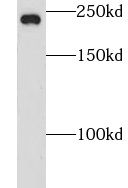Products
CNOT1 antibody
| Synonyms: | CCR4-NOT transcription complex subunit 1|CCR4-associated factor 1|Negative regulator of transcription subunit 1 homolog (NOT1H antibody, hNOT1)|CNOT1|CDC39|KIAA1007|NOT1 antibody | ||
| Catalogue No.: | FNab01805 | Reactivity: | Human, Mouse, Rat |
| Host: | Rabbit | Tested Application: | ELISA, IHC, WB, IP |
| Clonality: | polyclonal | Isotype: | IgG |
| Size | Price |
|---|---|
| 100µg | Inquiry |
- SPECIFICATIONS
- FIGURES
- CONDITIONS
- FAQS
- Product Name
- CNOT1 antibody
- Catalogue No.
- FNab01805
- Size
- 100μg
- Form
- liquid
- Purification
- Immunogen affinity purified
- Purity
- ≥95% as determined by SDS-PAGE
- Clonality
- polyclonal
- Isotype
- IgG
- Storage
- PBS with 0.02% sodium azide and 50% glycerol pH 7.3, -20℃ for 12 months(Avoid repeated freeze / thaw cycles.)
- Immunogen
- CCR4-NOT transcription complex, subunit 1
- Alternative Names
- CCR4-NOT transcription complex subunit 1|CCR4-associated factor 1|Negative regulator of transcription subunit 1 homolog (NOT1H antibody, hNOT1)|CNOT1|CDC39|KIAA1007|NOT1 antibody
- UniProt ID
- A5YKK6
- Observed MW
- 240-250 kDa, 174 kDa
- Tested Applications
- ELISA, IHC, WB, IP
- Recommended dilution
- WB: 1:500-1:2000; IP: 1:200-1:1000; IHC: 1:20-1:200
 human brain tissue were subjected to SDS PAGE followed by western blot with FNab01805(CNOT1 antibody) at dilution of 1:800
human brain tissue were subjected to SDS PAGE followed by western blot with FNab01805(CNOT1 antibody) at dilution of 1:800
 IP Result of anti-CNOT1 (IP:FNab01805, 5ug; Detection:FNab01805 1:500) with mouse kidney tissue lysate 4000ug.
IP Result of anti-CNOT1 (IP:FNab01805, 5ug; Detection:FNab01805 1:500) with mouse kidney tissue lysate 4000ug.
 Immunohistochemistry of paraffin-embedded human heart tissue slide using FNab01805(CNOT1 Antibody) at dilution of 1:200
Immunohistochemistry of paraffin-embedded human heart tissue slide using FNab01805(CNOT1 Antibody) at dilution of 1:200
- Background
- Scaffolding component of the CCR4-NOT complex which is one of the major cellular mRNA deadenylases and is linked to various cellular processes including bulk mRNA degradation, miRNA-mediated repression, translational repression during translational initiation and general transcription regulation. Additional complex functions may be a consequence of its influence on mRNA expression. Its scaffolding function implies its interaction with the catalytic complex module and diverse RNA-binding proteins mediating the complex recruitment to selected mRNA 3'UTRs. Involved in degradation of AU-rich element(ARE)-containing mRNAs probably via association with ZFP36. Mediates the recruitment of the CCR4-NOT complex to miRNA targets and to the RISC complex via association with TNRC6A, TNRC6B or TNRC6C. Acts as a transcriptional repressor. Represses the ligand-dependent transcriptional activation by nuclear receptors. Involved in the maintenance of emryonic stem(ES) cell identity.
How many times can antibodies be recycled?
First, usually it's not suggested to recycle antibodies. After use, buffer system of antibodies has changed. The storage condition of recycled antibodies for different customers also varies. Thus, the performance efficiency of recycled antibodies can’t be guaranteed. Besides, FineTest ever conducted the antibody recycling assay. Assay results show recycling times of different antibodies also varies. Usually, higher antibody titer allows more repeated use. Customers can determine based on experimental requirements.
Notes: After incubation, we recycle rest antibodies to centrifuge tube and store at 4℃. High titer antibodies can be stored for a minimum of one week. Reuse about three times.
What are components of FineTest antibody buffer?
Components of FineTest antibody buffer are usually PBS with proclin300 or sodium azide, BSA, 50% glycerol. Common preservative is proclin300 or sodium azide, which is widely applied in the lab and industry.
How about the storage temperature and duration of FineTest antibodies?
Most antibodies are stored at -20℃. Directly-labeled flow cytometry antibodies should be stored at 2 - 8℃. The shelf life is one year. If after sales issues for purchased antibodies appear, return or replacement is available. Usually, antibodies can be still used after the one-year warranty. We can offer technical support services.
Is dilution required for FineTest antibodies? What’s the dilute solution?
Directly-labeled flow cytometry antibodies are ready-to-use without dilution. Other antibodies are usually concentrated. Follow the dilution ratio suggested in the manual. Dilute solution for different experiments also varies. Common antibody dilution buffers are acceptable(e.g. PBST, TBST, antibody blocking buffer).
How to retrieve antibodies for immunohistochemistry?
Common retrieval buffers: Tris-EDTA Buffer(pH 9.0); Citrate Buffer(pH 6.0)
Heat induced antibody retrieval:
Method 1: Water-bath heating: Put the beaker with retrieval buffer and slide in the boiling water bath. Keep the boiling state for 15min. Naturally cool to room temperature;
Method 2: Microwave retrieval: Put the beaker with retrieval buffer and slide in the microwave oven. Heat at high power for 5min, Switch OFF for 3min, Heat at medium power for 5min. Naturally cool to room temperature.
How to choose secondary antibodies?
(1) Secondary antibodies react with primary antibodies. Thus, secondary antibodies should be against host species of primary antibodies. E.g. If the primary antibody is derived from rabbit, the relevant secondary antibody should be against rabbit. E.g. goat anti rabbit or donkey anti rabbit.
(2) Choose secondary antibody conjugates according to the experimental type, e.g. ELISA, WB, IHC etc. Common enzyme conjugated secondary antibodies are labelled by HRP, AP etc. Fluorescin or dye labelled secondary antibodies are applied in immunofluorescence and flow cytometry(e.g. FITC, Cy3).
